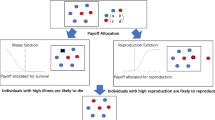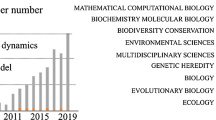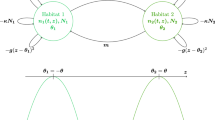Abstract
Many studies of the evolution of life-history traits assume that the underlying population dynamical attractor is stable point equilibrium. However, evolutionary outcomes can change significantly in different circumstances. We present an analysis based on adaptive dynamics of a discrete-time demographic model involving a trade-off whose shape is also an important determinant of evolutionary behaviour. We derive an explicit expression for the fitness in the cyclic region and consequently present an adaptive dynamic analysis which is algebraic. We do this fully in the region of 2-cycles and (using a symbolic package) almost fully for 4-cycles. Simulations illustrate and verify our results. With equilibrium population dynamics, trade-offs with accelerating costs produce a continuously stable strategy (CSS) whereas trade-offs with decelerating costs produce a non-ES repellor. The transition to 2-cycles produces a discontinuous change: the appearance of an intermediate region in which branching points occur. The size of this region decreases as we move through the region of 2-cycles. There is a further discontinuous fall in the size of the branching region during the transition to 4-cycles. We extend our results numerically and with simulations to higher-period cycles and chaos. Simulations show that chaotic population dynamics can evolve from equilibrium and vice-versa.
Similar content being viewed by others
References
Boldin, B., Geritz, S. A. H., & Kisdi, É. (2009). Superinfections and adaptive dynamics of pathogen virulence revisited: a critical function analysis. Evol. Ecol. Res., 11, 153–175.
Boots, M., & Haraguchi, Y. (1999). The evolution of costly resistance in host-parasite systems. Am. Nat., 153, 359–370.
Bowers, R. G., White, A., Boots, M., Geritz, S. A. H., & Kisdi, E. (2003). Evolutionary branching/speciation: contrasting results from systems with explicit or emergent carrying capacities. Evol. Ecol. Res., 5, 883–891.
Bowers, R. G., Hoyle, A., White, A., & Boots, M. (2005). The geometric theory of adaptive evolution: trade-off and invasion plots. J. Theor. Biol., 233, 363–377.
Cushing, J. M., Costantino, R. F., Dennis, B., Desharnais, R. A., & Henson, S. M. (2003). Chaos in ecology [electronic resource]: experimental nonlinear dynamics. Amsterdam: Academic Press.
De Mazancourt, C., & Dieckmann, U. (2004). Trade-off geometries and frequency-dependent selection. Am. Nat., 164, 765–778.
Doebeli, M., & Koella, J. C. (1995). Evolution of simple population-dynamics. Proc. R. Soc. Lond. Ser. B, Biol. Sci., 260, 119–125.
Ebenman, B., Johansson, A., Jonsson, T., & Wennergren, U. (1996). Evolution of stable population dynamics through natural selection. Proc. R. Soc. Lond., Ser. B, Biol. Sci., 263, 1145–1151.
Eckmann, J. P., & Ruelle, D. (1985). Ergodic-theory of chaos and strange attractors. Rev. Mod. Phys., 57, 617–656.
Ferriere, R., & Gatto, M. (1993). Chaotic population-dynamics can result from natural-selection. Proc. R. Soc. Lond., Ser. B, Biol. Sci., 251, 33–38.
Gatto, M. (1993). The evolutionary optimality of oscillatory and chaotic dynamics in simple population-models. Theor. Popul. Biol., 43, 310–336.
Geritz, S. A. H., Kisdi, E., Meszena, G., & Metz, J. A. J. (1998). Evolutionarily singular strategies and the adaptive growth and branching of the evolutionary tree. Evol. Ecol., 12, 35–57.
Geritz, S. A. H., Kisdi, E., & Yan, P. (2007). Evolutionary branching and long-term coexistence of cycling predators: critical function analysis. Theor. Popul. Biol., 71, 424–435.
Greenman, J. V., Benton, T. G., Boots, M., & White, A. R. (2005). The evolution of oscillatory behavior in age-structured species. Am. Nat., 166, 68–78.
Gurney, W. S. C., & Nisbet, R. M. (1998). Ecological dynamics. New York: Oxford University Press.
Katok, A., & Hasselblatt, B. (1995). Introduction to the modern theory of dynamical systems. Cambridge: Cambridge University Press.
Kisdi, E. (2001). Long-term adaptive diversity in Levene-type models. Evol. Ecol. Res., 3, 721–727.
Levins, R. (1962). Theory of fitness in a heterogeneous environment 1. Fitness set and adaptive function. Am. Nat., 96, 361.
May, R. M. (1975). Deterministic models with chaotic dynamics. Nature, 256, 165–166.
Metz, J. A. J., Nisbet, R. M., & Geritz, S. A. H. (1992). How should we define fitness for general ecological scenarios. Trends Ecol. Evol., 7, 198–202.
Metz, J. A. J., Geritz, S. A. H., Meszena, G., Jacobs, F. J. A., & Van Heerwaarden, J. S. (1996). Adaptive dynamics: a geometric study of the consequences of nearly faithful reproduction. In: S.J.M. Van Strien & S.M. Verduyn Lunel (Eds.), Stochastic and spatial structures of dynamical systems (pp. 183–231). Amsterdam: North-Holland.
Mueller, L. D., Joshi, A., & Borash, D. J. (2000). Does population stability evolve? Ecology, 81, 1273–1285.
Prasad, N. G., & Joshi, A. (2003). What have two decades of laboratory life-history evolution studies on Drosophila melanogaster taught us? J. Genet., 82, 45–76.
Roff, D. A. (2002). Life history evolution. Sunderland: Sinauer Associates.
Rueffler, C., Van Dooren, T. J. M., & Metz, J. A. J. (2004). Adaptive walks on changing landscapes: Levins’ approach extended. Theor. Popul. Biol., 65, 165–178.
Schaffer, W. M. (1974). Selection for optimal life histories—effects of age structure. Ecology, 55, 291–303.
Stearns, S. C. (1992). The evolution of life histories. Oxford: Oxford University Press.
Svennungsen, T. O. & Kisdi, É. (2009). Evolutionary branching of virulence in a single infection model. J. Theor. Biol., 257, 408–418.
White, A., & Bowers, R. G. (2005). Adaptive dynamics of Lotka-Volterra systems with trade-offs: the role of interspecific parameter dependence in branching. Math. Biosci., 193, 101–117.
White, A., Greenman, J. V., Benton, T. G., & Boots, M. (2006). Evolutionary behaviour in ecological systems with trade-offs and non-equilibrium population dynamics. Evol. Ecol. Res., 8, 387–398.
Author information
Authors and Affiliations
Corresponding author
Rights and permissions
About this article
Cite this article
Hoyle, A., Bowers, R.G. & White, A. Evolutionary Behaviour, Trade-Offs and Cyclic and Chaotic Population Dynamics. Bull Math Biol 73, 1154–1169 (2011). https://doi.org/10.1007/s11538-010-9567-7
Received:
Accepted:
Published:
Issue Date:
DOI: https://doi.org/10.1007/s11538-010-9567-7




